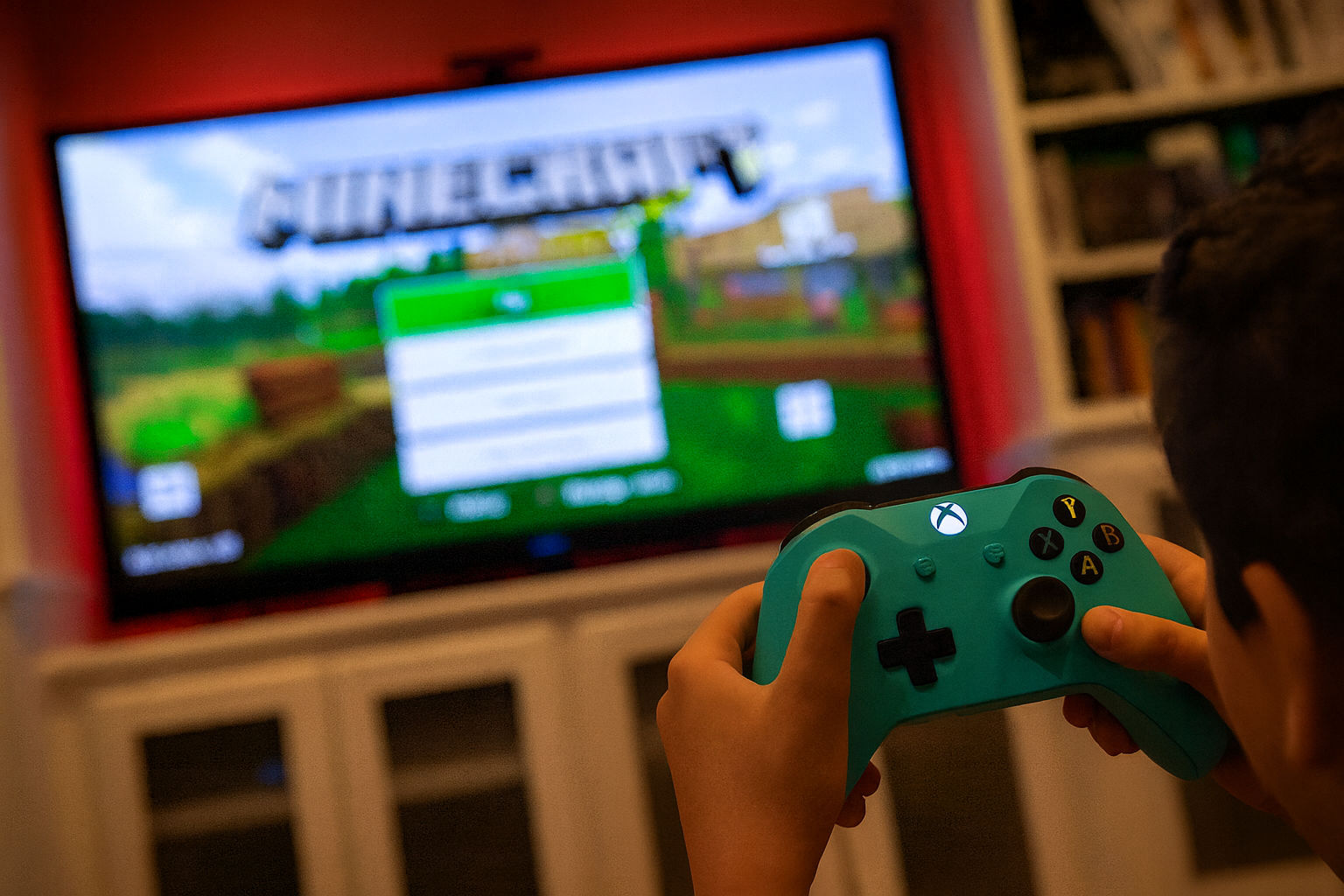- Age-appropriate gaming depends on emotional maturity, personality, and family values, not just official ratings.
- Family dialogue and shared values reduce conflict, strengthen trust, and guide safe, balanced gaming habits.
- Careful evaluation of game themes, design, and online interactions builds resilience and supports digital safety.
Parents often check official ratings when looking for age-appropriate games. These labels help spot issues like violence or explicit content, but they don’t tell the whole story. Two kids the same age can react very differently. A game that excites one might overwhelm another. Ratings can’t capture a child’s personality, sensitivities, or a family’s values.
It helps to look beyond rules and think about whether a game matches a child’s stage of emotional growth. Parents usually know best. A child who gets frustrated easily may struggle with competitive games, while one who loves open play may thrive in creative worlds.

Seen this way, finding the right games becomes less about rules and more about relationships and insight. Choosing what’s suitable becomes an opportunity to connect by asking questions, listening, and showing genuine curiosity and interest in the game. Instead of conflict, games can build trust and create guidance that feels supportive and collaborative.
The best way to assess whether a game is suitable is to try it yourself or watch a few gameplay recordings, and take the ratings into consideration when deciding.
Gaming as a family conversation
Opening the dialogue
The most effective way to guide children toward suitable games is to talk with them rather than at them. Parents often feel tempted to dictate rules, but this approach can create secrecy, distance, and conflict. Open-ended questions shift the dynamic and show genuine interest:
- “Can you show me how this game works?”
- “What do you like about playing with your friends here?”
- “What’s your favorite part of this story or world?”
By asking these kinds of questions, parents invite their children to share their experiences. This creates a foundation of trust, so that later conversations about safety or boundaries feel less like control and more like guidance. When parents understand the details of the game, any boundaries or discussions later on will be more meaningful for both parents and children.
Agreeing on shared values
Once dialogue is open and parents have some insight to base their opinions and rules on, families can begin talking about what really matters to them. Instead of laying down rules from above, parents and children can name values together:
- Parents might emphasize kindness and respectful interaction.
- Children may say they want creativity or the ability to play with friends.
- Together, families may agree to look for games that reflect both sets of priorities.
When values are shared, the boundaries that grow from them feel less like restrictions and more like agreements or compromise. Children learn not only how to make safer choices but also how to reflect critically on whether a game aligns with values, and to understand parents' informed decision on saying no to a game or setting boundaries.
Developmental stages and game fit
Early childhood (Ages 3–6)
At this stage, games are best seen as playful extensions of imagination. Parents might notice:
- Creativity-focused titles like simple drawing or building games that encourage exploration.
- Gentle problem-solving games with simple puzzles that avoid high pressure.
- Supervised play, where a parent sits close by, turning the screen into a shared activity.
The goal here is not achievement but joyful exploration. Parents can guide gently by observing how children react, whether they grow frustrated, anxious, or engaged, and adjust choices accordingly.
Middle childhood (Ages 7–9)
Children in this age group often crave more complexity and collaboration. Helpful choices may include:
- Cooperative adventure or puzzle games that encourage teamwork.
- Creative sandboxes like Minecraft, where building and problem-solving shine.
- Conversations about peer influence, since “all my friends play this,” become common.
Parents can co-play or ask reflective questions about strategies and feelings. This not only supports growth but also shows children that their parents value their gaming worlds.
Preteens and teens (Ages 10–14+)
As kids get older, games become more social and competitive. Parents can guide thoughtfully by focusing on:
- Respecting the social aspect of games.
- Encouraging reflection with questions like, “How do you feel after playing this?”
- Discussing online safety, including what to share and what to keep private, when children are old enough to manage online interactions.
At this stage, teens benefit from being treated as partners in dialogue rather than subjects of control. Respect for and knowledge about their gaming world make them far more likely to bring challenges or worries to their parents.
How to evaluate games with care
Themes and narratives
Every game tells a story. Some encourage resilience, cooperation, or creativity, while others normalize violence or stereotypes. By getting to know the game, parents can assess whether a game’s themes align with family values; for instance, teamwork in a fantasy quest may fit, while glorifying cruelty may not.
This doesn’t have to be rigid. Conversations about games can spark reflections about what they communicate and whether they align with the values a family wants to nurture. Often, these talks grow into broader discussions about kindness, fairness, and responsibility.
Game design and motivation
Not all games are designed with the same intentions. Some support growth, while others encourage compulsive play. Parents can help children notice these patterns by pointing out:
- Creativity and mastery – games that let children build, create, or problem-solve.
- Endless reward loops – designs that rely on frustration and quick rewards to keep players hooked.
- In-app purchases or loot boxes – features that push spending as part of gameplay.
Instead of simply forbidding, parents can ask, “How do you feel when a game keeps asking for purchases?” These conversations build awareness, helping children make mindful choices and notice for themselves when a game feels draining rather than joyful. If a child is begging to play a game that parents find too stressful or focused on purchases, they can consider agreeing on limited screen time for this particular game.
Online interaction and safety
Online games often include chat, trading, or friend requests from strangers. These features can add richness but also risk. Privacy settings can sometimes be adjusted to restrict online communication to fit a child's age and maturity.
When children are old enough to handle this aspect of gaming, parents can sit with them to set agreements about what is safe to share and how to respond to uncomfortable situations.
Online communication holds a real risk that older children need to know about and learn how to handle.
When children know their parents are approachable and non-judgmental, they are more likely to come forward if something goes wrong. The goal is not to shield them and keep them unaware of challenges and online dangers, but to prepare them with tools and support.
Real-life parenting stories
A parent who said yes
One parent shared how her 9-year-old begged to play a game she had heard troubling things about. Instead of dismissing it, she chose to sit beside him during the first sessions.
What she found surprised her:
- laughter and creativity in the gameplay
- problem-solving at the heart of his choices
- a fun activity to do together with friends
- options for gameplay settings to adjust the difficulty level and minimize violence and competition to fit his age
Gaming, once seen as a threat, became an unexpected bridge for connection.
A family that built agreements
One family with two teenagers found success by creating gaming agreements together rather than enforcing rigid rules. Their process included:
- Sitting down as a family to talk about what mattered most: respect, balance, and fun.
- Learning about the game, the kids wanted to play to base their decisions on knowledge and experience.
- Agreeing on respectful language during gaming.
- Deciding together how to balance schoolwork, outdoor activity, and screen time.
- Adjusting the agreed screen time to the natural flow of the game.
- Choosing to increase support like signals and reminders rather than punishments when things slipped.
Because the children helped shape these agreements, they felt more ownership and were more likely to keep them. Conflicts decreased, and the family noticed that cooperation and communication grew stronger.

Frequently asked questions parents have
What is the most kid-friendly game?
There isn’t a single “most kid-friendly” game, because every child is different. Some children enjoy the calm creativity of Animal Crossing, while others thrive in the open-ended worlds of Minecraft. The best game is the one that leaves your child feeling safe, happy, and proud to share what they’ve built or achieved.
What age is appropriate for gaming?
There is no universal age. Some preschoolers enjoy simple puzzles or educational games, while others may not be ready for more complex play until later. A helpful guide is to notice how your child responds:
- Do they stay calm and engaged?
- Do they become frustrated or restless?
- Does the game bring joy rather than stress?
Your child’s reactions will tell you more than a number on a rating label.
What is a good family game for all ages?
Games that invite everyone to join in are usually the best family choices. Mario Kart, Stardew Valley, or lighthearted party games often work well across generations. The most valuable part isn’t winning or losing, it’s laughing together and making memories.
How can I tell if a game is age-appropriate?
Game rating systems like ESRB or PEGI give a helpful overview of content and complexity. They highlight things like violence, language, or online features. These are useful as a guide, but the best test is watching how your child responds and asking yourself if the game fits your family’s values.
Should I only rely on game ratings when choosing?
No. While ratings are helpful, parents should also consider:
- The specific child’s ability to handle content themes (competition, violence, online interactions, mature storylines, etc.)
- Complexity of controls and gameplay (too difficult or too easy may frustrate or bore kids)
- Educational or positive value (problem-solving, teamwork, creativity)
What should I do if my child wants to play a game that seems inappropriate?
Start with getting to know the game, either first-hand by playing the game, or by reading reviews or watching recorded gameplay. Have a calm conversation. Ask what excites them about the game and share your concerns in return. Together you can:
- Preview clips or read reviews to form your own decision based on knowledge of whether the game is right for your child.
- Suggest safer alternatives that still offer adventure or creativity, or consider adjusting game settings to an easier or less competitive mode if possible.
- Explain clearly why you feel it’s not a good fit right now. Acknowledge their frustration, especially if their friends are allowed to play the game.
- If the game seems okay at an older age, then give a timeline for when it will be okay to play or to discuss it again.
When children feel included in the decision, they’re more likely to accept guidance even if the answer is “not yet.”





